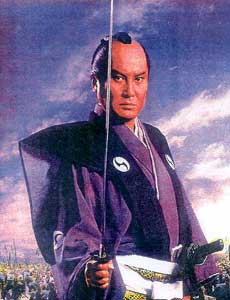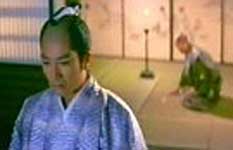 In the Genroku era the Tokugawa shogunate was using any excuse to terminate hereditary daimyo (lords) of sundry fiefs, confiscating their lands & holdings, & abolishing even their names. Serious breaches of formal behavior at Edo Castle could have catastrophic outcomes, as will unfold in Ako-jo danzetsu (Swords of Vengeance: The Fall of Ako Castle, Toei, 1978). In the Genroku era the Tokugawa shogunate was using any excuse to terminate hereditary daimyo (lords) of sundry fiefs, confiscating their lands & holdings, & abolishing even their names. Serious breaches of formal behavior at Edo Castle could have catastrophic outcomes, as will unfold in Ako-jo danzetsu (Swords of Vengeance: The Fall of Ako Castle, Toei, 1978).
On 14 March 1702, during preparations for a tea ceremony, the small-minded & mean-spirited Kazukenosuke Kira (Nobuo Kaneka) began haranguing a young rural daimyo, Takuminokami Asano (Teruhiko Saigo), as too much of a bumpkin to oversee such formal activities. Eventually Lord Asano had taken enough insults & drew his sword while in Edo Castle, attacking Lord Kira.
Dempachiro Okada (Hiroki Matsukata) investigates the incident & concludes both men deserve some degree of punishment, though he felt Asano had been so relentlessly provoked that he did have some justification. He is alarmed when the judgement that comes down requires Asano to commit seppuku, but only imposes an easy retirement on the aging Kira. Matsukata provides an exemplarary performance as he tries to change the shogunate's harshly one-sided verdict against Asano.
Tetsuro Tamba plays Yoshiyasu Yanagisawa, the shogun's man who brings the edict for Asano to commit suicide & later conspires in the attempts to keep Asano's masterless vassals from the trail of vengeance.
This is actual history. And all that arose from this incident might never have happened if the obnoxious Kira had also been instructed to commit seppuku, as it was not the punishment that so inspired vengeance but the imbalance of the punishment.
Yasubei Horibe (Toru Minegishi), vassal or "disciple" of Lord Asano, is the only one of Asano's men permitted to see him before he committed seppuku. He lamented that he did not have the time to explain himself & was sorry his men would doubtless believe he had betrayed them. His other regret was that he failed in his intent to kill Kira.
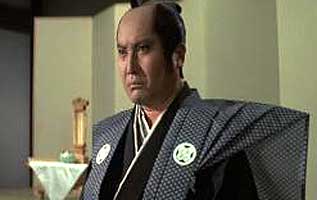 Kinnosuke Yorozuya (still better known by his previous name Kinnosuke Nakamura & in Japan fondly known just as Kinnosuke) stars as Kuranosuke Oishi, the leader of the brave 47 ronin. He plays his character between stoic realism when disguising emotion & kabukiesque elegant excess when revealing emotion. As the central pillar of a film with mostly snap-shot characterizations, Kinnosuke provides the closest thing to stability or continuity in Kenji Fukasaku's take on the famous story. Kinnosuke Yorozuya (still better known by his previous name Kinnosuke Nakamura & in Japan fondly known just as Kinnosuke) stars as Kuranosuke Oishi, the leader of the brave 47 ronin. He plays his character between stoic realism when disguising emotion & kabukiesque elegant excess when revealing emotion. As the central pillar of a film with mostly snap-shot characterizations, Kinnosuke provides the closest thing to stability or continuity in Kenji Fukasaku's take on the famous story.
Ako Castle is so distant from Edo that it takes four days by relay-palanquin to get news to Oishi, an exhausting ride for the vassal who brings the first news to Ako. Within a few more days, Oishi calls for Asano's loyal men to gather, with the implication that they will all commit suicide in order to follow their master into death. Many clansmen flee the province or otherwise disappear, but fifty-six arrive, most prepared to slit their stomachs open immediately, a few to protest that harakiri should not be an option for as long as Kira lives & their master is unavenged.
Oishi reveals that he had mentioned hirakiri so that only Asano's most faithful would show up. In reality vengeance is his intent. "The sole target is Kazukenosuke Kira. Kira's head on a stake!" Even knowing what will befall themselves & their families by pursuing this course, they had already proven by their arrival that they were willing to make the ultimate sacrifice, & loyalty demands this action against Kira even if all must be punished by death. The men together write their oaths of vendetta & sign their letters of intent with a thumbprint of their own blood.
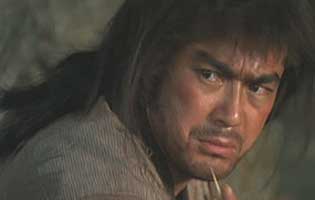 In a story largely ritualistic in its presentation, every director to tackle this familiar tale likes to bring something new to his version. Kinji Fukasaku brought Shinichi "Sonny" Chiba. He plays Kazuemon Fuwa, an outcast ronin formerly regarded as the strongest swordsman of the Asano clan, exiled from Ako due to some past incident of murder. In a story largely ritualistic in its presentation, every director to tackle this familiar tale likes to bring something new to his version. Kinji Fukasaku brought Shinichi "Sonny" Chiba. He plays Kazuemon Fuwa, an outcast ronin formerly regarded as the strongest swordsman of the Asano clan, exiled from Ako due to some past incident of murder.
Fuma is a hulking ronin who returns to Ako to offer his services in case Asano's men decide to baracade the castle instead of turning it over to the shogunate. In this role Chiba rises far above his usual high camp acting style. He owns the screen every time he appears. His performance is strongly reminiscent of Toshiro Mifune in his prime as the scruffy ronin of Yojimbo & Sanjuro.
He haunts the woodlands around Oishi's home, protecting Oishi from Kira's assassin spies. He does not rejoin the brave ronin officially until the raid on Kira's mansion. Every scene Chiba walks into is rivetting, & it's unfortunate this classy performance isn't his usual method.
For 630 days Asano's suffering samurai, now masterless ronin, await the order from Oishi to make their raid on Kira's mansion. For 630 days they were in furtive rebellion against the shogunate, while shogunate spies kept track of them hoping to find out what they have planned. Oishi begins to live a dissolute life to throw the shogunate off the trail, which has the effect of alienating some of his followers who are losing their patience.
The story moves glacially as a feast for the eyes. The first 25 minutes take us only as far as Asano's act of seppuku, & even that occurs off-screen. The next hour of the film's epic length is full of posing, emoting, planning, suffering, but really only one token scene of physical action.
If a viewer fails to connect emotionally with the tragedy & the injustice, then the details of the repurcussions may well seem tedius. A feeling of sentimentality is required to fully appreciate the story of the brave 47 ronin, so that every static tableau is infused with tension & feeling. It will not be carried along on speed of action.
This story has been filmed well over one-hundred times from the silent era to the present. It's as familiar to the Japanese as the story of Moses is to Jews & Christians, with nearly as deep a spiritual dimension. There are no real "surprises" in a story already this well known, & the effectiveness really is in the details of presentation.
There are so many characters that provide familiar actors with mere cameos, & there's an attempt to tell mini-stories about a few of the individual ronin or their wives. Kyoko Enami of The Woman Gambler series plays Oishi's wife Ukihashi, & her shared belief in her husband's duty to avenge Asano, despite that it could well mean her destruction too, is powerfully played. Her sorrow & pride in her oldest son, the youngest of the Brave 47, is as credible as any mother of any soldier who could die in battle.
The mini-tale of Hashimoto (Masaomi Kondo) & his wife Hatsu (Mieko Harada) stands out most powerfully among the mini-tales. Hashi had become a depressed womanizing drunkard no longer pursuing vengeance, & his wife has fallen into prostitution to support him. The day that Jujiro Hazama (Kensaku Morita) comes to announce the final raid on Kira's mansion, it is too late for Hashimoto, who is full of bitterness & resentment that this couldn't have been done before his unutterable downfall.
In the argument that ensues he attempts to kill Jujiro, but his wife stabs him with apologies, because she knows her beloved husband is incapable of the mission but that Jujiro must survive to make the raid against Kira. Mortally wounded, Hashi cuts down his wife, carves open his own stomach, & tells Jujiro to tell Oishi that Hashimoto was too ill to attend the final raid but has gone on ahead of them into death.
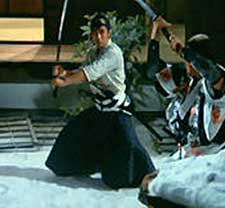 The beautiful march through the snow, toward the mansion to finally kill Kira on 14 December 1703, is so beautiful, & reminiscent of old block prints commemorating this very occurence. There is no music on the soundtrack at this point, there is only the sound of snow crunching under footfalls. Wonderful! The beautiful march through the snow, toward the mansion to finally kill Kira on 14 December 1703, is so beautiful, & reminiscent of old block prints commemorating this very occurence. There is no music on the soundtrack at this point, there is only the sound of snow crunching under footfalls. Wonderful!
Up to now, director Fukusaku has been excessively restrained throughout the film. A director famed for gory excesses has relied on psychological vignettes & gorgeous costumes & sets & emotive dialogue. But anyone familiar with the director will be expecting this raid to be much more graphic than in most filmic versions. This expectation is now on the verge of being fulfilled.
The Uesegi clan is awakened in the night, quick to Kira's defense, some of them only half clad or in their bedclothes. Mayhem & chaos is the style for the choreography much as in Fukasaki's violent yakuza films, savagely at odds with the mannered tone of the bulk of the film. Despite the chaotic nature of the battles, individual personalities are revealed in the action, from Kira hiding like the coward he certainly is to the bold efforts of the young Uesegi lord who, despite being ill, strives nobly to stop Oishi's men.
In the protracted battle, this one duel stands out in the chaos as a beautiful one-on-one encounter, the young Uesegi lord against Oishi's strongest man, Fuma. Shinichi Chiba was the fight choreographer & in many films he has choreographed, he goes over-the-top with acrobatics & all kinds of corny maneuvers. But this encounter is realistic, rapid, exhausting, filled with beauty & honor for both men.
Fukasaku has given us quite a good version of Chushingura. He has brought very little to the story that is new, however, & to some degree he is out of his element striving to be so damned tasteful. Though a very long film, it is actually shorter than many versions of Chushingura which tended to be released as two films rather than one. The plethora of characters means few if any are on screen more than a few minutes, & entire stories are told in slow motion in a matter of a few minutes, then it's on to yet another vignette told in slow motion. Without a powerful central figure to anchor the film, Fukasaku's direction likewise wavers without focus.
He was instructed to do it this way by Toei Studios who had only recently returned to big epic historical films & preferred something safe like the perennially popular story of the 47 ronin. This version is adapted from the play Kanadehon Chushingura (The Treasury of Loyal Retainers), written by Takeda Izumo II, Miyoshi Sh┘raku, & Namiki Sosuke in 1748. It remains to this day the single most popular kabuki & bunraku play in Japan, having been almost continuously in production literally for centuries!
That play is the source of the majority of films about the valorous forty-seven, for typical example, Hiroshi Inagaki's Chushingura: Hana no maki yuki no maki (The Brave 47 Ronin: I. Blossoms, II. Snow, Toho, 1962). Apart from variations of focus on various of an expansive choice of characters, Fukasaki might just as well have been refilming a condensed version of the very script used by Inagaki for his even longer two-part epic. To great extent the story is much too well known in Japan for directors to take too many liberties with it.
Given that an over-the-top yakuza director like Fukasaku is for once posing as a classic-style director, he does a fine imitation of Japan's classier directors, but it's only an imitation. Fukasaku eventually made the personal version he really wanted to direct, the excesses-ridden Crest of Betrayal (Chushingura Gaiden: Yotsura kaidan,1994) mixing the 47 Ronin story with a well known tale of supernatural vengeance.
Fukasaku is more in his element with the film's action. There is very little swordplay in most of the film, but when the raid on the mansion is finally engaged, it is probably the bloodiest Chushingura version ever filmed. In the aftermath he reverts to Mizoguchiesque bloodlessness as the mass-suicide shows us everything, in slow motion, except the actual acts of disemblowlment & beheading. The contrast is actually a very strong one, the extreme graphic action of the raid followed by the mannered theatrics of embracing their punishment in a manner strangely wholesome. I was moved by it.
copyright ę by Paghat the Ratgirl
|
